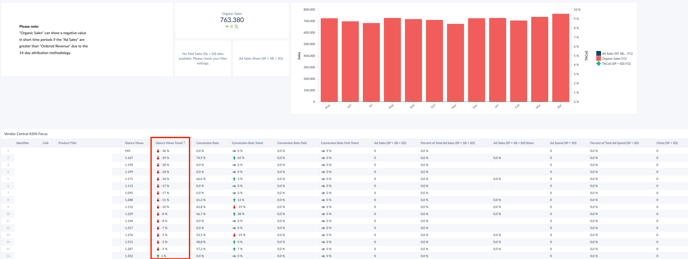Find out how to monitor for which ASINs you can see a drop in traffic and what the reasons could be.
Identifying ASINs with declining traffic is crucial because it directly impacts sales performance. By pinpointing the underlying causes—such as stock issues, inadequate advertising, poor content, or increased competition—you can implement targeted strategies to restore and enhance traffic, thereby improving overall sales and market share.
1. Where to find the metrics
2. Why is the traffic decreasing
3. How to Optimize ASINs with Declining Traffic
Where to find the metrics?
Vendor Traffic Diagnostic:
This report provides an overview of your total and advertising traffic. By analyzing this data, you can determine if there's an overall drop in traffic or if it's specific to advertising channels.
To find out which ASINs are declining in traffic specifically, click the month in the table, to view detailed metrics on traffic trends and identify any significant drops.
Vendor ASIN Focus Dashboard:
This dashboard allows you to monitor traffic changes at the ASIN level. You can identify which products are experiencing a decline in glance views and examine related KPIs such as stock levels, ad spend, PDP Ad Score, sales rank, negative ratings, price increases, content quality, and visibility.

Vendor Product Performance Dashboard:

Why is the traffic decreasing
Stock Availability:
If your ASINs are out of stock, they won't show up in search results or be available for purchase. Even a short period of stockout can significantly affect traffic. You can check your inventory levels in the Inventory Dashboard, ASIN Focus, or Product Performance Dashboard and see if out-of-stock events correlate with traffic drops.
Pricing and Discount Changes:
Competitor Actions:
Advertising Performance:
If you run advertising campaigns, a reduction in ad spend or a drop in ad performance could lead to reduced visibility. Track your advertising metrics and compare them with traffic drops to see if there’s a direct correlation.
Content or Listing Quality:
Search Rank Changes:
How to Optimize ASINs with Declining Traffic
1. Ensure Stock Availability
- Why It’s Important: If your product is out of stock, it will not be visible to customers, which leads to zero traffic.
- How to Optimize:
- Regularly monitor inventory levels
- Set up Born2Run if possible
- Use the Run Rate and Forecasting Metrics in the Inventory Dashboard to track your stock levels and plan accordingly for high-demand periods.
2. Optimize Content Quality
- Why It’s Important: Amazon’s algorithm prioritizes listings that are complete, relevant, and high-quality. Poor content can negatively affect your listing’s visibility and attractiveness to customers.
- How to Optimize:
- Titles: Ensure your product title is clear, descriptive, and includes relevant keywords that customers are likely to search for.
- Images: Use high-quality images that show the product from multiple angles. Consider adding lifestyle images to showcase the product in use.
- Descriptions: Provide clear, detailed product descriptions that highlight key features, benefits, and specifications. Incorporate relevant keywords naturally.
- Bullet Points: Use bullet points to emphasize key features of the product, making it easier for customers to scan the most important information.
- Customer Reviews: Actively manage customer reviews. Respond to negative reviews and ensure your product maintains a high rating. This can improve customer trust and increase conversions.
3. Improve Search Visibility and Keywords
- Why It’s Important: If your ASIN is not ranking well for the right keywords, it won’t appear in search results, reducing traffic.
- How to Optimize:
- Keyword Optimization: Review your keyword strategy. Ensure your listing includes high-traffic, relevant keywords in the title, bullet points, description, and backend search terms.
- Competitor Analysis: Use the Visibility Dashboard and Market Insights to see what keywords competitors are ranking for. Adjust your keyword strategy to target underserved or high-traffic keywords.
- A/B Testing: Run A/B tests on different keywords or content variations to find the combination that drives the most traffic.
- Backend Search Terms: Ensure you’re making the most of backend search terms by including additional relevant keywords that customers might use to find your product.
4. Enhance Advertising Campaigns
- Why It’s Important: If your advertising efforts are underperforming, your ASIN may not be getting enough visibility, which leads to lower traffic.
- How to Optimize:
- Increase Ad Spend: If you’ve identified that your ads are underfunded, increase the budget to maintain consistent visibility.
- Refine Targeting: Ensure that your ads are targeting the most relevant customer segments. Use Amazon’s Sponsored Products and Sponsored Brands to target keywords and competitors.
- Optimize Ad Copy and Creative: Test different ad copy and creative to find the most effective messaging that drives clicks.
- Analyze Performance: Use the Advertising Reports to track your ad performance and adjust bids and targeting for optimal results.
6. Address Customer Sentiment and Reviews
- Why It’s Important: Negative reviews and low ratings can severely affect traffic and conversion rates. Amazon’s algorithm favors products with higher ratings and positive customer feedback.
- How to Optimize:
- Respond to Negative Reviews: Address concerns raised by customers and offer solutions where possible.
-
- Improvement Based on Feedback: If common issues are being raised in reviews (e.g., product quality, functionality), work with your team to address them and improve the product or its packaging.
7. Adjust to Market Changes
- Why It’s Important: The market is dynamic, and competition can affect your traffic and sales.
- How to Optimize:
- Competitor Tracking: Use the Market Insights tool to track new competitors and shifts in customer behavior.
- Seasonal Adjustments: Prepare for seasonal variations by adjusting your product offerings, inventory, and advertising campaigns.
- New Trends: Keep an eye on emerging market trends, especially those relevant to your product category. Adjust your marketing and positioning to leverage these trends.

